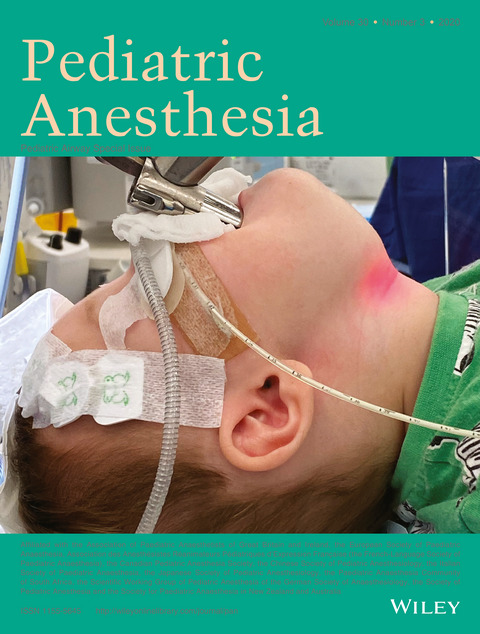Below you will find links to articles and editorials. Many of the linked articles below are behind paywalls, however all can be accessed with your Open Athens account or via the access that comes with membership of the RCOA, AAGBI and/or APAGBI:
Neonatal & Infant Airway Management
Airway management in neonates and infants: European Society of Anaesthesiology and Intensive Care and British Journal of Anaesthesia joint guidelines. Disma, N et al. British Journal of Anaesthesia, 132 (1): 124-144 (2024)
Laryngospasm
Laryngeal reflex responses in pediatric anesthesia. Erb et al. Pediatric Anesthesia, 30(3): 353-361 (2020)
Pediatric Laryngospasm. Hampson-Evans et al. Pediatric Anesthesia, 18(4): 303-307 (2008)
Laryngospasm: review of different prevention and treatment modalities. Alalami A et al. Pediatric Anesthesia, 18 (4): 281-288 (2008)
Rapid Sequence Induction
Rapid sequence induction has no use in paediatric anesthesia. Engelhardt T. Pediatric Anesthesia. 25(1): 5-8 (2015)
Rapid sequence induction in children – it’s not a matter of time! Weiss & Gerber. Pediatric Anesthesia. 18 (2): 97–99 (2008)
Cuffed Vs Uncuffed Tubes
Time to stop using uncuffed tracheal tubes in children?. Bailey C. Anaesthesia, 73(2): 147-150 (2018)
Paediatric Tracheostomy Care
Perioperative management of a child with a tracheostomy. Okonkwo et al. BJA Education, 20(1): 18-25 (2020)
Multidisciplinary guidelines for the management of paediatric tracheostomy emergencies. Doherty et al. Anaesthesia, 73(11): 1400-1417 (2018)
eFONA
Emergency front-of-neck access in pediatric anesthesia: A narrative review. Haag A-K et al. Emergency front-of-neck access in pediatric anesthesia: A narrative review. Pediatr Anesth. 34: 495-506 (2024)
Acute Airway Infections
Paediatric Airway Infections. Davies & Jenkins. BJA Education, 17(10): 341-345 (2017)
Foreign Body
Essential notes: the anaesthetic management of an inhaled foreign body in a child. Bould, M. BJA Education, 19(3): 66-67 (2019)
HFNO
There have been two recent multi-centre RCTs of note:
Hamster Trial (2024)
High-flow nasal oxygen for children’s airway surgery to reduce hypoxaemic events: a randomised controlled trial (The Hamster trial). Humphreys S et al. The Lancet Respiratory Medicine. 12(7): 535-543 (2024)
Paediatric anaesthesia: it is not only what you do, but how you do it. (The Hamster trial editorial). Engelhardt, T et al. The Lancet Respiratory Medicine. 12(7): 501-503 (2024)
Kids THRIVE (2025)
Effectiveness of nasal high-flow oxygen during apnoea on hypoxaemia and intubation success in paediatric emergency and ICU settings: a randomised, controlled, open-label trial (The Kids THRIVE trial). George, S et al. The Lancet Respiratory Medicine. 13(6): 545-555 (2025)
Nasal high-flow oxygen for apnoeic oxygenation during emergency endotracheal intubation of children (The Kids THRIVE trial editorial). Alexander, E et al. The Lancet Respiratory Medicine. 13(6): 480-482 (2025)
Don’t Forget the Bubbles Review of The Kids THRIVE trial. Karageorgos, S et al (2025)
Before these two RCTs the following review article was published in 2019:
Nasal high-flow oxygen in pediatric anesthesia and airway management. Humphreys, S et al. Pediatric Anesthesia (Pediatric Airway Special Issue). 30(3): 339-346. (2020)
Shared Airway
Anesthesia for pediatric rigid bronchoscopy and related airway surgery: Tips and tricks. Wang, J et al. Pediatric Anesthesia. 32(2): 302-311. (2022)
Anesthesia for shared airway surgery in children. Bradley, J et al. Pediatric Anesthesia (Pediatric Airway Special Issue). 30(3): 288-295. (2020)

In 2020 Pediatric Anesthesia published a Special Issue with multiple articles on the Paediatric Airway
